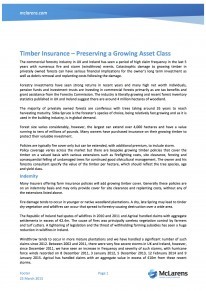By Frank McGaffney, Manager for Scotland, Agrical
The commercial forestry industry in UK and Ireland has seen a period of high claim frequency in the last 5 years with numerous fire and storm (windthrow) events. Catastrophic damage to growing timber in privately owned forests can have serious financial implications for the owner’s long term investment as well as debris removal and replanting costs following the damage.
Forestry investments have seen strong returns in recent years and many high net worth individuals, pension funds and investment trusts are investing in commercial forests primarily as are tax benefits and grant assistance from the Forestry Commission. The industry is literally growing and recent forest inventory statistics published in UK and Ireland suggest there are around 4 million hectares of woodland.
The majority of privately owned forests are coniferous with trees taking around 35 years to reach harvesting maturity. Sitka Spruce is the forester’s species of choice, being relatively fast growing and as it is used in the building industry, is in global demand.
Forest size varies considerably, however, the largest can extend over 4,000 hectares and have a value running to tens of millions of pounds. Many owners have purchased insurance on their growing timber to protect their valuable investment.
Policies are typically fire cover only but can be extended, with additional premium, to include storm. Policy coverage varies across the market but there are bespoke growing timber policies that cover the timber on a valued basis with various extensions such as firefighting costs, site clearance, fencing and consequential felling of undamaged trees for continued good silvicultural management. The owner and his forestry consultant specify the value of the timber per hectare which should reflect the tree species, age and yield class.
Indemnity
Many Insurers offering farm insurance policies will add growing timber cover. Generally these policies are on an indemnity basis and may only provide cover for site clearance and replanting costs, without any of the extensions listed above.
Fire damage tends to occur in younger or native woodland plantations. A dry, late Spring may lead to tinder dry vegetation and wildfires can occur that spread to forestry causing destruction over a wide area.
The Republic of Ireland had spates of wildfires in 2010 and 2011 and Agrical handled claims with aggregate settlements in excess of €2.4m. The cause of fires was principally careless vegetation control by farmers and turf cutters. A tightening of legislation and the threat of withholding farming subsidies has seen a huge reduction in wildfires in Ireland.
Windthrow tends to occur in more mature plantations and we have handled a significant number of such claims since 2012. Between 2002 and 2011, there were very few severe storms in UK and Ireland, however, since December 2011, we have seen an increase in frequency and severity of such storms, with hurricane force winds recorded on 8 December 2011, 3 January 2012, 5 December 2013, 12 February 2014 and 9 January 2015. Agrical has handled claims with an aggregate value in excess of £10m from these recent storms.
Aerial Survey
Following such storms, forest owners and managers have to visit all their plantations to inspect for damage. The policies stipulate claims require to be intimated within 30 days. Given the size of forests and their remote locations, forest management companies will often charter a plane to fly over all their properties.
The handling of a claim on a valued policy may sound like a straightforward process – apply the agreed value to the area of damage. Unfortunately forestry claims can be extremely complex. The adjuster is often faced with hazardous site visits in very remote areas of the country, only accessible on foot and there is rarely mobile phone reception. Barricades of uprooted trees makes the measurement exercise, using hand held GPS devices impossible and in such cases ortho-rectified aerial photography is obtained from specialist aerial survey companies, utilising stiff winged aircraft or UAV’s (drones). Forest surveys by satellite are currently in the development stage.
Agreeing areas for consequential felling for good management purposes can be the subject of some debate. This cover allows the owner to fell undamaged trees to rationalise the shape of the damaged area to allow replanting. Some owners argue the entire forest is compromised following a storm and look for Insurers to settle at the full sum insured. This is not the intention of the policy extension and on occasion an independent chartered forester may need to be consulted.
Salvage
Windthrown trees can retain significant value. Salvage can either belong to the owner or insurer depending on the policy. When property of the insurer, the adjuster requires to work with the forest manager and owner to have this harvested to maximise the salvage value. We have had the situation where forest owners have not read the policy and did not realise the insurer retains the salvage.
The handling of fire claims can be more straightforward, but we need to be aware of the possibility of seemingly destroyed trees reviving to full health.
Having the right policy for the forest owner’s needs and expectations, regularly reviewed with updated values, is essential to protect a very valuable investment. This is such a specialist area of insurance, it is important to consult a broker with knowledge in this field. The handling of claims requires an appropriately experienced adjuster prepared to travel to the remotest areas of the country, in the wildest of weathers and be suitably fit to walk long distances, climb fences and fallen trees as well as be familiar with forestry practice and bespoke growing timber policy wordings.
This article was originally published in the 23 March 2015 edition of Insurance Day.
Timber Insurance – Preserving a Growing Asset Class
Please click the button below to download a copy of this article.





